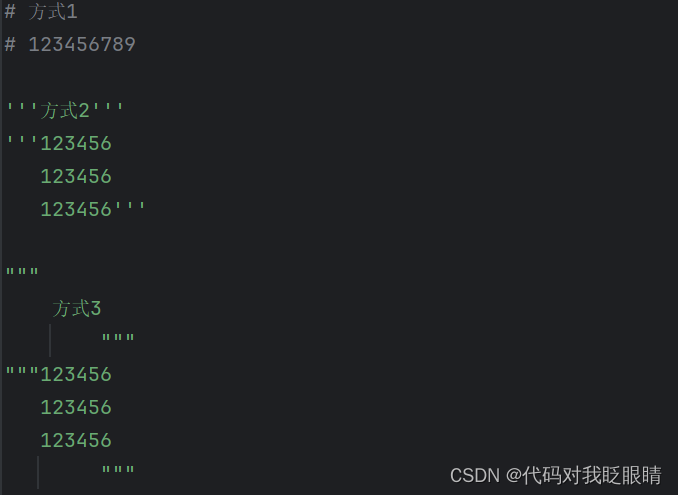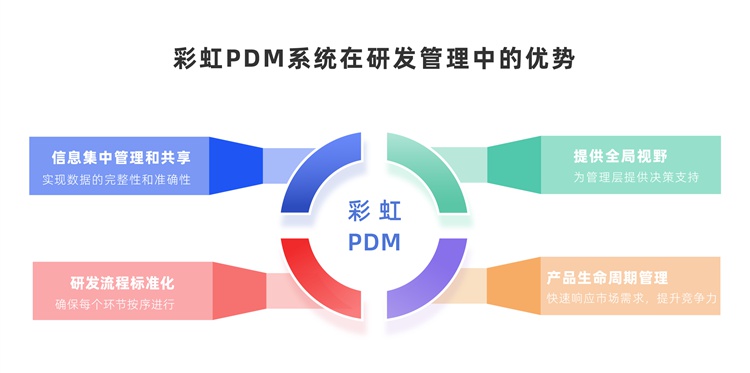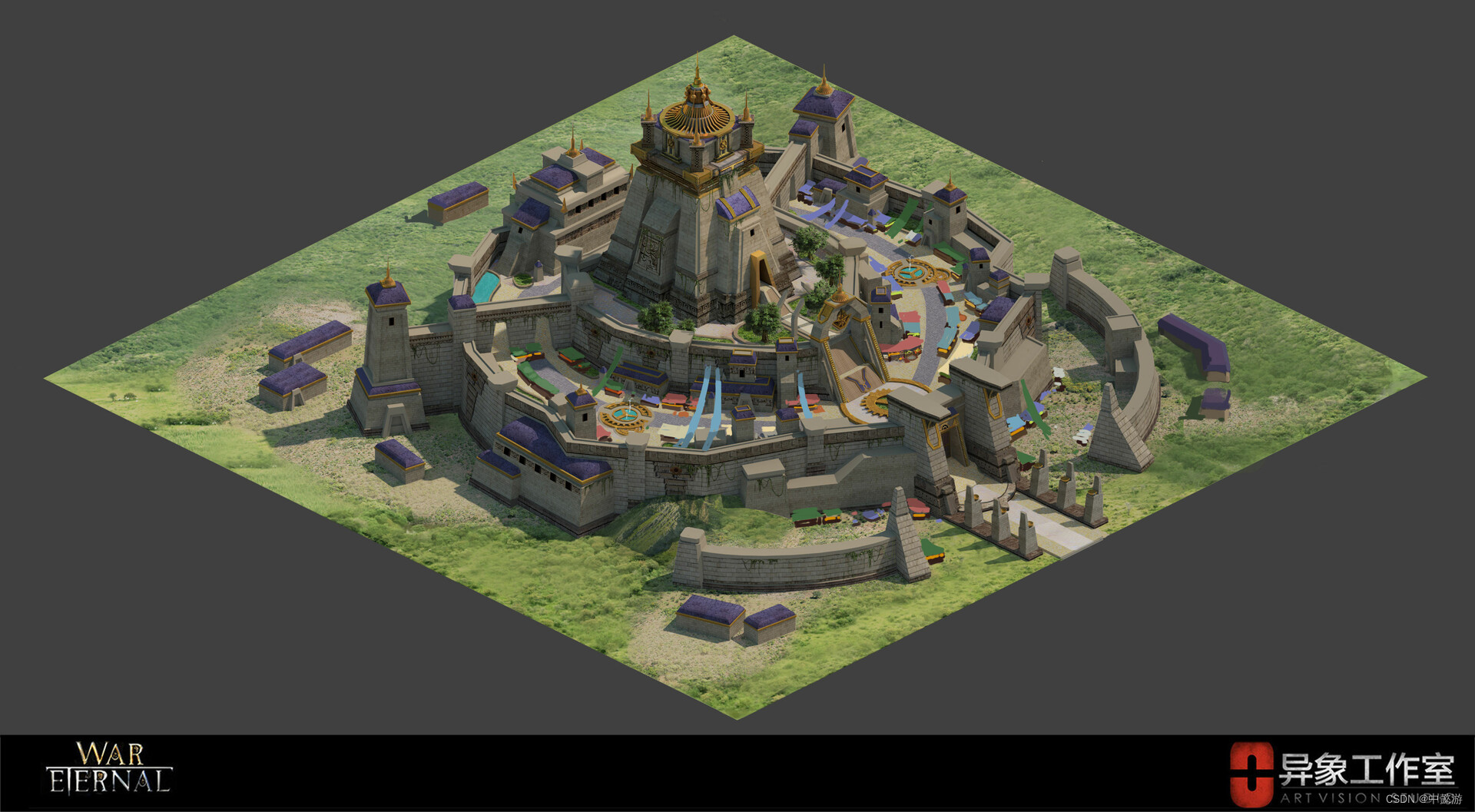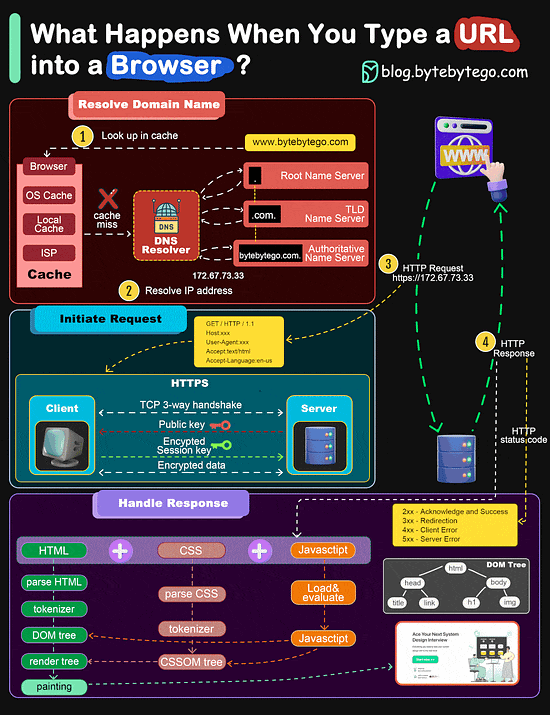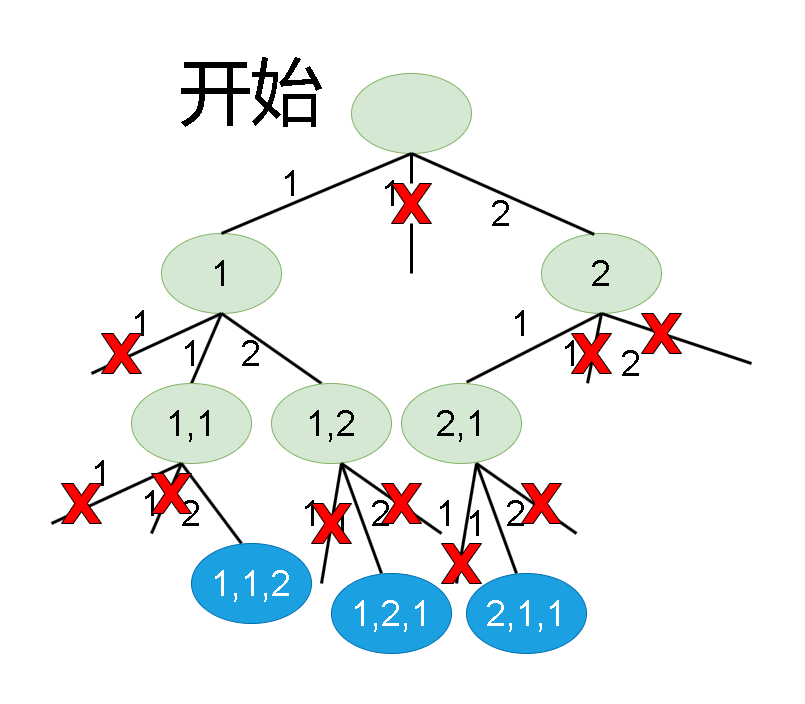什么是排序树
说一下普通二叉树可不是左小右大的

插入的新节点是以叶子形式进行插入的
二叉排序树的中序遍历结果是一个升序的序列
下面是两个典型的二叉排序树


二叉排序树的操作
构造树的过程即是对无序序列进行排序的过程。

存储结构
通常采用二叉链表作为存储结构 不能

插入算法

下面插入一个图解

上面的×就表示会在当前位置给delete掉一个结点
查找算法

删除算法



第三种情况:你删除的结点下面就是说还有左右子树,那么这个时候,我们就要去找到这棵树中序遍历结果之后的直接前驱或者直接后继,然后把这个前驱或者后继给按到删除结点这个位置上,将它下面的树移到被替换结点的位置

删除操作的具体讲解
重点讲解一下删除节点的核心分析

这里在补一张中序遍历的递归调用图

直接上代码
在上代码之前,先来说一下,二叉搜索树很多方法都利用了递归的思想,许多说明我都放到代码注释里面了,可以结合下面的这张图进行思维分析
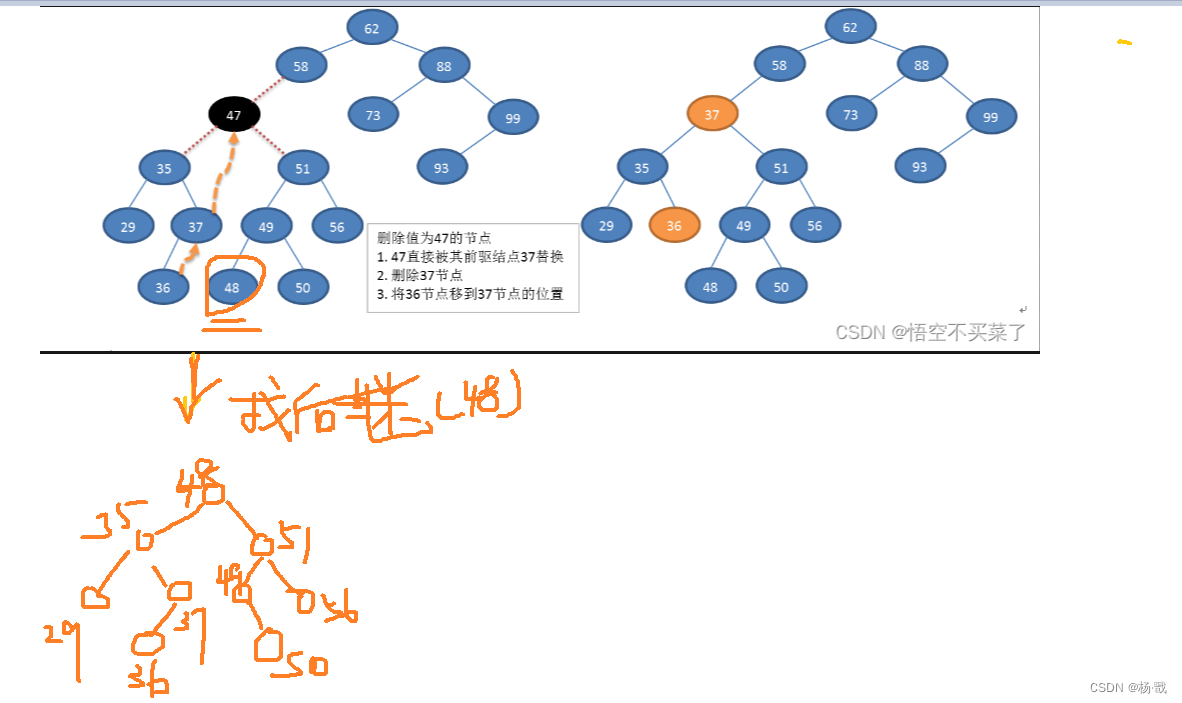
先来看c语言代码(algorithm/bst/bst1.c)
#include <stdio.h>
#include <stdlib.h>
typedef int key_type;
typedef struct _node
{
key_type key;
struct _node *left;
struct _node *right;
}node, *pnode;
void insert_bst(pnode *root, key_type key)
{
//初始化插入结点
pnode p = (pnode)malloc(sizeof(node));
if (p != NULL)
{
p->key = key;//把值给放进去
p->left = p->right = NULL;
}
//空树的时候,直接作为根结点
if (*root == NULL)
{
*root = p;
return;
}
//插入到当前结点的左孩子
if ((*root)->left == NULL && (*root)->key > key)
{
(*root)->left = p;//直接在堆上面指就可以了
return;
}
//插入到当前结点的右孩子
if ((*root)->right == NULL && (*root)->key < key)
{
(*root)->right = p;
return;
}
//上面都没有进入,说明结点就要往下继续存放
//需要先把我们分配的结点内存给释放掉
free(p);
//左子树递归
if ((*root)->key > key)
{
insert_bst(&(*root)->left, key);
}
//右子树递归
else if((*root)->key < key)
{
insert_bst(&(*root)->right, key);
}
}
//根据关键字删除某个结点,成功返回1,失败返回0
int delete_bst(pnode *root, key_type key)
{
if (*root == NULL)
{
return 0;//这是一棵空树
}
if ((*root)->key == key)
{
pnode pbak1, pmove;
//判断右子树是否为空,为空,只需要重接左子树
if ((*root)->right == NULL)
{
//把当前结点的左子树接上去就可以了
pbak1 = *root;//当前结点备份等会释放
//改变在栈上面一级指针的指向
*root = (*root)->left;
//删除
free(pbak1);
}
//左子树为空的情况下,只需要重接右子树就行了
else if ((*root)->left == NULL)
{
//删除结点的空间备份
pbak1 = *root;
*root = (*root)->right;//改变栈上结点的指向
free(pbak1);
}
//左右子树都不为空
else
{
//我们要找到直接前驱或者一个直接后继
//前驱就是当前结点下一个结点左边结点的右边(尽头),所以先把root指向了左结点
pbak1 = *root;//删除结点的一个备份
pmove = (*root)->left;//左边等会要接接上
//再来循环右边
//注意的问题是我们需要指向一个直接前驱的父结点
//以便于用来更改当前的子树结点,也就是被删除结点的下一个结点要连接上去
while (pmove->right)
{
pbak1 = pmove;//前驱结点的父节点
pmove = pmove->right;//这个是指向了我们需要的前驱结点
}
//s指向了前驱结点,将s放到root结点上面
(*root)->key = pmove->key;//改变了值,不是地址,等会吧pmove给释放掉
//重接一下下面结点的子树
//如果pbak1没有移动过,那么pbak1->left = pmove ->left;
if (pbak1 == *root)
{
pbak1->left = pmove->left;
}
else
{
//如果移动过,那么pbak1->right就要改变
pbak1->right = pmove->left;
}
//释放掉pmove这个结点
free(pmove);
}
return 1;
}
//没有找到的情况下,我们需要遍历树
else if (key < (*root)->key)
{
//直接走左子树
//这里必须return ,不然找到了也会false
return delete_bst(&(*root)->left, key);
}
else if (key > (*root)->key)
{
//大于当前结点就直接走右子树
return delete_bst(&(*root)->right, key);
}
return 0;
}
//查找元素,找到返回结点指针,没找到返回NULL
//找结点,传入一个一级指针就好了
pnode search_bst(pnode root, key_type key)
{
if (root == NULL)
{
return NULL;
}
//查找右子树
if (key > root->key)
{
return search_bst(root->right, key);
}
//查找左子树
else if (key < root->key)
{
return search_bst(root->left, key);
}
else
{
return root;
}
}
//查找最小的关键字,空树时返回NULL
pnode search_min_bst(pnode root)
{
if (root == NULL)
{
return NULL;
}
//最小的话应该就是最左边孩子
if (root->left == NULL)
{
return root;//叶子结点下面都是NULL
}
else
{
return search_min_bst(root->left);
}
}
//查找最大关键字,空树时返回NULL
pnode search_max_bst(pnode root)
{
if (root == NULL)
{
return NULL;
}
//找到最后的孩子
if (root->right == NULL)
{
return root;
}
else
{
//一直往右边找,直到没有有孩子结点
return search_max_bst(root->right);
}
}
//中序遍历二叉树
void inorder_traverse_bst(pnode root)
{
if (root != NULL)
{
//遍历左子树
//先走到最左边,依次调用结束,返回打印
inorder_traverse_bst(root->left);
//走到最后一个结束,打印,中间根结点也会打印
printf("%d ", root->key);
//然后走右边开始打印
inorder_traverse_bst(root->right);
}
}
int main()
{
//创建一棵二叉树
pnode root = NULL;
insert_bst(&root, 3);
insert_bst(&root, 8);
insert_bst(&root, 2);
insert_bst(&root, 5);
insert_bst(&root, 4);
insert_bst(&root, 9);
insert_bst(&root, 11);
//中序遍历二叉树
inorder_traverse_bst(root);
delete_bst(&root, 2);
printf("\n---------------------\n");
inorder_traverse_bst(root);
return 0;
}
再来看java的运行代码(algorithm/bst1)
package com.pxx.tree.bst1;
class Node {
int key;
Node left, right;
//这里就是在new的时候可以出初始化一个头结点
public Node(int key) {
this.key = key;
this.left = this.right = null;
}
}
class BstTree {
//插入结点
public Node insertBst(Node root, int key) {
if (root == null) {
//直接返回这个新结点
//指到最后可添加位置,也是直接指向这个新节点
return new Node(key);
}
if (key < root.key) {
//往左边走
root.left = insertBst(root.left, key);
} else if(key > root.key) {
//往右边走
root.right = insertBst(root.right, key);
}
return root;//这里返回root的意思也就是中间的结点必须连上
}
//删除结点
public Node deleteBST(Node root, int key) {
if (root == null) {
return root;
}
if (key < root.key) {
root.left = deleteBST(root.left, key);
} else if (key > root.key) {
root.right = deleteBST(root.right, key);
} else {
//找到了这个结点
if (root.left == null) {
//直接返回这个结点的右结点给上一个节点
return root.right;
} else if (root.right == null) {
return root.left;
}
//上面都没有进入,说明有左右子树,需要结点上一移动
//先改变查找到结点的值,我们需要用它的直接后继来替换
//也就是找到它右边的结点,然后不停的左边,一直到尽头
root.key = minValue(root.right);
//改变结点之间的连接
root.right = deleteBST(root.right, root.key);
}
return root;
}
// 寻找最小值
//从某个结点一直找到最左边就是最小值
public int minValue(Node root) {
while (root != null && root.left != null) {
root = root.left;
}
return root.key;
}
//中序遍历这个结点
public void inorderTraverseBst(Node root) {
if (root != null) {
//先打印左边
inorderTraverseBst(root.left);
System.out.print(root.key + " ");
inorderTraverseBst(root.right);
}
}
//查找某一个元素
public Node searchBST(Node root, int key) {
if (root == null || root.key == key) {
return root;
}
if (key < root.key) {
return searchBST(root.left, key);
}
return searchBST(root.right, key);
}
}
public class Solution {
public static void main(String[] args) {
BstTree bstTree = new BstTree();
Node root = null;
//root在堆上就已经建立空间
root = bstTree.insertBst(root, 3);
bstTree.insertBst(root, 8);
bstTree.insertBst(root,2);
bstTree.insertBst(root,5);
bstTree.insertBst(root,4);
bstTree.insertBst(root,9);
bstTree.insertBst(root,1);
//中序遍历这片空间
bstTree.inorderTraverseBst(root);
System.out.println("-----------------");
bstTree.deleteBST(root,2);
bstTree.deleteBST(root,8);
bstTree.inorderTraverseBst(root);
}
}
好了,说到这。





